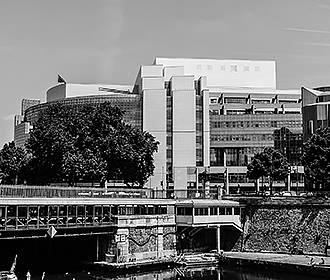The Paris Opera Bastille History
Originally a group of people came together in the 1960s discussing the idea of building a new Paris Opera House, as they felt there was a need for a more modern theatre that would appeal to the masses, rather than the elaborate building that houses the Opera Garnier.
The idea first came from the composer Pierre Boulez, along with Maurice Bejart who was a dancer and choreographer and Jean Vilar, who was a theatre director and a believer in the need for popular theatre.
Grand projects in Paris
So they filed a report with the French Government, but it was only at the start of the 1980s when the French President, Francois Mitterrand, had the ideas for some grand projects in Paris and when he read the report, he was inspired.
He decided to go with the idea of a new, modern and popular place for opera in Paris and classical music, which would appeal more to the masses, along with other projects he put in place such as the pyramid at the Musee du Louvre, the Musee d’Orsay, the Grande Arche in the La Defense area of Paris, etc.
Then Francois Mitterrand decided to created an international competition to select an architect for this grand project, that he wanted built in the Bastille area, which was called the Opera Bastille Public Establishment Competition, and after over 700 different entries, it was short listed to three architects.
The competition was actually anonymous and many people were hoping that it would be the recognised American architect Richard Meier who would have the winning design, with the selection panel thinking they had chosen the modern audience friendly style that the French President wanted, so typical of the famed architect.
Eventually, the overall winner was announced in the November of 1983 and the competition was actually won by a relatively unknown architect called Carlos Ott, which was a complete surprise to to the selection panel. Originally from Uruguay, at that time, Carlos Ott was living and working in Canada, and after this major achievement, he went on to become an internationally renowned architect, winning competitions for his designs from all over the world.
The specific site chosen was the old Paris Bastille train station called the Gare de la Bastille that was located on one side of the Place de la Bastille square. This particular train station had originally opened in 1859, but closed in 1969 and after this saw a few exhibitions and concerts before being completely shut.
Therefore, the old train station buildings were demolished in 1984, to make way for this innovative new opera building that was meant to take the place of the old fashioned, yet extremely elegant and plush Opera Garnier. However, the Opera Garnier is still open, and is still very much a part of the history of Paris with its incredible ballet performances that people travel to see from all over the world.
Eventually, the French President Francois Mitterrand, officially inaugurated the new Opera Bastille on 14th July 1989 at Place de la Bastille, in order to commemorate the bicentenary of the French Revolution and the storming of the Bastille.
There was also a gala concert held for the inauguration ceremony that was conducted by Georges Pretre and featured singers such as Teresa Berganza and Placido Domingo, however, the first opera performance to be conducted at the Paris Opera Bastille, was not until 17th March 1990.
And yet, even though this was to replace the aristocratic and lavish Palais Garnier Opera house, they are both still running and are just as popular as ever, not just for their performances, but also as Paris tourist attractions as well.
Although, even today the building itself still draws criticism for its external appearance, just like the Pompidou Centre, The Louvre Pyramid, and other modern iconic buildings in Paris do. Yet seeing more than 900,000 spectators each year enjoying concerts, ballet, opera and other performances, the Paris Opera Bastille also plays host to some of the world's greatest musicians, stage directors and choreographers, which will no doubt continue for many years to come.
Transport options
Paris Metro lines 1, 5, 7, 8
Bus lines 24, 29
Bus line 57
Bus lines 61, 63, 67, 69
Bus lines 72, 76, 77
Bus lines 86, 87
Bus lines 91, 96
Night bus lines N01, N02
Night bus lines N11, N16
Night bus lines N31, N34
Night bus line N144
